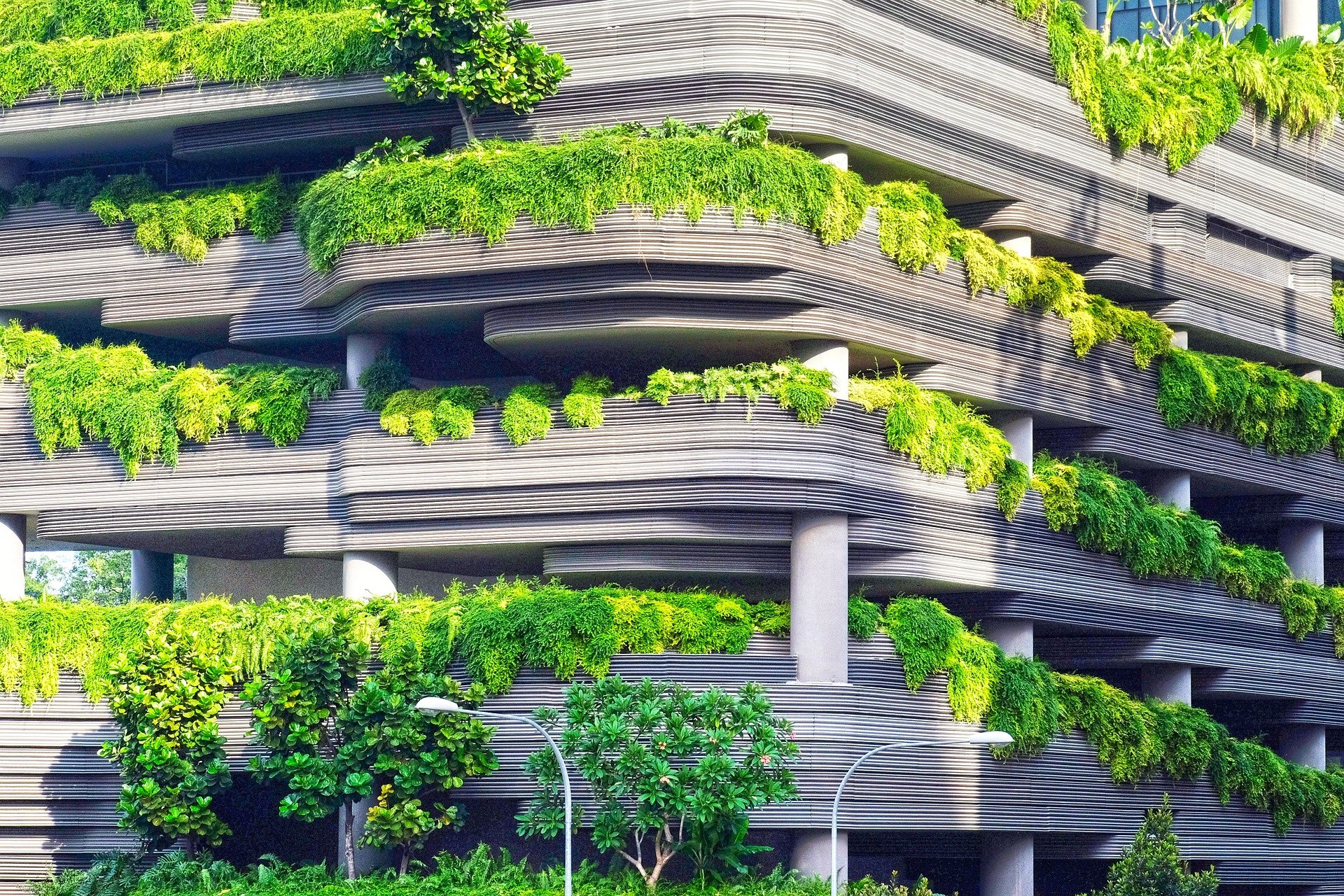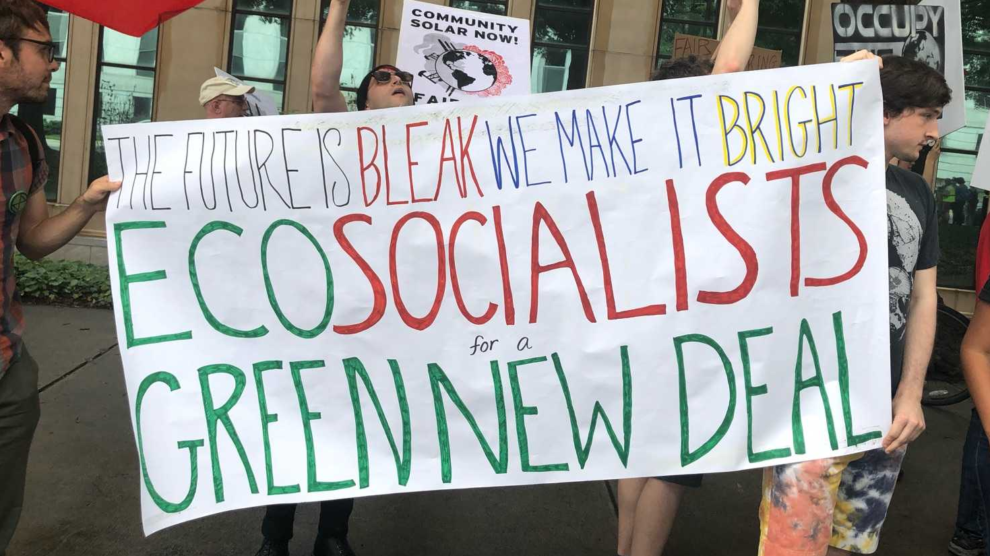February 5, 2021
Technical and Social Dimensions of Decarbonizing the Built Space
By Benjamin Silverman

Decarbonizing buildings has the potential to cut greenhouse gas (GHG) emissions about 30 percent in the United States.1 At minimum, to meet the Paris Agreement’s commitment of limiting global warming to 1.5 degrees Celsius, all buildings in the United States need to be retrofitted to be 50 percent more energy efficient, according to one analysis.2 To do so the technical gaps, socially constructed hurdles, and key contradictions of capitalist energy economy will need to be overcome. Current policy approaches focus primarily, if not exclusively, on the first of these.
Within each of the 120 million buildings in the United States are multiple systems which determine the technical parameters for how to decarbonize our building stock and energy infrastructure.3 Understanding the technical challenges of decarbonization helps to set the stage for understanding the social hurdles that need to be overcome.
A well designed envelope system — that is the building’s windows, exterior walls, roof, all the barriers between it and the outside environment — will ideally have the right level of insulation in the walls and airtightness attuned for its specific climate.4 Too much insulation and you will have heat and indoor moisture problems. Too little insulation or too much of the envelope taken up by windows, and your building’s interior comfort will be off balance, creating heat gain problems from the sun and cold patches near the windows, which require large mechanical energy inputs to correct.
The quality of the envelope determines the nature and size of the heating, ventilation, and air conditioning (HVAC) system needed. While some energy is going to be needed for HVAC in many climates for at least part of the year, a good envelope can drastically reduce that energy demand, limiting it to just the coldest or hottest days. But architectural trends across the twentieth century have largely deprioritized energy efficiency in the United States.5 Today, the industry trend of glass curtain wall high rises has made the fight for more energy efficient buildings far more difficult.6 The best windows on the market today are still worse at resisting heat transfer than most walls.7
The work to lower HVAC energy demand by reducing heat loss from ventilation and the envelope, along with increasing the efficiency of appliances, electronics, and lighting, is bent towards two interrelated goals. One is electrification: removing all on-site combustion of fossil fuels, such as natural gas or oil furnaces, boilers, water heaters, and stoves, and replacing them with efficient electrical-based systems. The second is to ensure that the entirety of buildings’ electrical demand is sourced from renewable energy, some combination of on-site solar photovoltaics and/or off-site renewable electricity from the grid.8 The role of energy efficiency work in the building decarbonization transition is to enable a great “meeting in the middle” with renewables. The more efficient the building stock, the less time and money is needed to build out a 100 percent renewable electricity sector. This is the recipe for a net zero carbon built environment.
What does this mean from a standpoint of politics? It can be expensive, labor-intensive, and often logistically challenging due to site constraints and existing occupants to retrofit existing low-performing buildings to be net zero carbon levels of efficiency, so getting it right the first time is critical. Every new, inefficient, carbon-emitting building built today is a costly net zero retrofit for tomorrow. Building codes — which regulate the design of new construction — need to be aligned with net zero carbon standards, even against industry resistance.9 Winning such requirements is a political and technical battle, but it is becoming winnable as recent changes to building codes in California and internationally have shown.10 These changes in the highly technical and industry-friendly codes are becoming possible due to continued pressure from the climate movement, the ongoing drumbeat of scientific evidence demonstrating that current approaches are insufficient to reduce GHG emissions, and the emergence of high profile concepts like the Green New Deal.
Requiring all new construction to be net zero in design is the relatively easy part. Enough projects have been completed to date to show it is doable, the technical challenges can be overcome, and the cost premium is minor.11 It is in the social and political realm where there are hurdles to be overcome. Major and rapid transformations will be needed in construction, a historically conservative industry with small profit margins, in which many private firms will resist taking on the type of risks and expenses of retraining their workers for the shift to new net zero building methods. A Green New Deal that provides public funds to de-risk this transition, retrain workers, and enforce minimum requirements for net zero buildings can help to overcome gaps inherent to the private sector.
Retrofitting the 120 million odd already existing buildings to a net zero standard however will be the hard part. This is because retrofitting existing buildings comes up against more significant technical issues compared to new construction, as well as the whole existing economic model for how retrofits are done.
Here again, there are structural problems inherent in the capitalist real estate market that limit the adoption of widespread deep green energy retrofits. Many landlords have little incentive to pay for major efficiency improvements as only the tenant will benefit in terms of lower energy bills. In the building sustainability field this catch-22 is called the “split incentive problem” and it stands as a major contradiction for market based net zero retrofits.12
When energy efficiency retrofits do take place, most projects focus on measures that have quick returns on investment and shallower impacts on emissions reduction, so-called low hanging fruit. In these projects, energy cost savings are the measure of success, not carbon savings. Common measures in these projects include replacing light bulbs with light-emitting diodes (LEDs), older taps with low-flow shower heads, and fuel oil boilers at their end of life with natural gas boilers. While these help to lower energy costs they mostly fall short of the deep whole-building retrofit work needed for decarbonization that can achieve emissions reduction above 50 percent.13 For example, an LED lighting retrofit alone can cut total energy usage between 4 and 12 percent, though the cost savings can be significant.14
As a result, financing has been easier for low cost, quick return weatherization campaigns, but not for high cost, slower return deep carbon reduction retrofits. Opening up walls to insulate, replacing roofs and windows, and electrifying HVAC systems are costly measures that have not often been pursued in the past. Because of limited data on comparable projects, and because projected energy cost savings accrue too slowly, risk-averse banks are resistant to lend money to pursue these measures. Without financing, market forces will not achieve adoption at scale.
Parallel to these trends, natural gas consumption has increased in the United States by 39 percent over the last two decades.15 It powers our HVAC systems, cooks our food, powers our grid, poisons our air, increases our carbon emissions, and contaminates our groundwater from fracking. Homes with natural gas stoves have indoor air nitrogen dioxide pollutant levels 50–400 percent higher than those with electric stoves.16 Long promoted as a “bridge fuel” away from dirtier coal in electricity generation, natural gas has proven to be a bridge to nowhere, as its lower costs compared to electricity have created a market and infrastructure dead-end that is proving hard to surmount.17 Once you factor in natural gas pipelines’ disastrous penchant for leaking, on a greenhouse gas potential measure, burning natural gas for electricity generation can be as or more dirty than coal.18
To achieve the goals of the Paris Agreement of limiting global warming to 1.5 degrees Celsius, there would need to be 2.6 million deep energy retrofit projects per year for the next thirty years in the United States. President Joe Biden’s current pledge to just weatherize two million homes over his first term pales in comparison to the breadth and depth of this task.19
To overcome these barriers, a generation of mass scale, whole building energy efficiency and electrification public subsidy and financing programs will be needed, combined with ever stricter requirements for building energy performance. The market has failed at adopting decarbonization at scale, so the United States government should finance this necessary work. Such massive investment that could come with a Green New Deal would dramatically transform the energy efficiency space, lowering emissions, creating jobs, and overcoming these market barriers.20 Such public largess would beg the question of ownership: if the government plows so much money into housing and other buildings, why should that real estate continue to be privately owned? What other problems could be solved with a different ownership structure less beholden to the strictures of private profit — perhaps the housing availability and cost crisis?
To find a real world model of what such a Green New Deal for housing might look like, one example to consider is the EnergieSprong program. First deployed in the Netherlands, the program’s main innovation is using prefabricated mass manufactured exterior panels to quickly and cheaply improve a building’s envelope. After scanning the existing exterior of the building, a manufacturer creates a number of puzzle piece-like insulated panels that are installed over the existing envelope. It’s kind of like giving the whole house a really big coat.
This approach is quick, relatively cheap, causes no major disruptions to occupants’ lives, and can be scalable for buildings with similar designs. Instead of spending months ripping out walls, blowing in new insulation, and air sealing, prefabricated insulated wall and roof panels can be installed in as little as a week.
The EnergieSprong approach solves many technical issues of deep retrofits for certain existing buildings, but leaves some of the social issues. To date the EnergieSprong program has retrofitted five thousand social housing buildings to a net zero carbon level of performance, with another twenty thousand planned across the European Union.21 This scale is far below what is needed in the European Union, let alone the United States, and again highlights the limitations of market-based financing models. EnergieSprong is built around financing retrofits primarily from their cost savings. In an economic model still dominated by the cost instead of the carbon savings of building decarbonization, such efforts can only go so far without the massive interventions by state actors under efforts like the Green New Deal.
—
Benjamin Silverman is a building sustainability professional based in Boston, MA. He received his MS in Environmental Policy and Sustainability Management in 2014 from The New School. He is a Certified Passive House Consultant and LEED AP: Building Design and Construction.
References
- “Sources of Greenhouse Gas Emissions,” Environmental Protection Agency, Last modified December 4, 2020, https://www.epa.gov/ghgemissions/sources-greenhouse-gas-emissions. Total building-related emissions include both Scope 1 emissions (direct on-site emissions, 12% of US total), and Scope 2 emissions (emissions from offsite generation of electricity that is consumed at the building, 20% of US total).
- Michael Thomas, “An Analysis of Joe Biden’s Climate Plan,” Carbon Switch, accessed December 10, 2020, https://carbonswitch.co/an-analysis-of-joe-bidens-climate-plan.
- 5.6 million commercial buildings and 118.2 million residential homes. “A Look at the U.S. Commercial Building Stock: Results from EIA’s 2012 Commercial Buildings Energy Consumption Survey (CBECS),” US Energy Information Administration, published March 4, 2015, https://www.eia.gov/consumption/commercial/reports/2012/buildstock/; “Residential Energy Consumption Survey (RECS),” US Energy Information Administration, last updated May, 2018, https://www.eia.gov/consumption/residential/data/2015/hc/php/hc10.1.php.
- “Passive House Principles,” Passive House Institute US, accessed December 10, 2020, https://www.phius.org/what-is-passive-building/passive-house-principles.
- Adam Rome, The Bulldozer in the Countryside: Suburban Sprawl and the Rise of American Environmentalism (New York: Cambridge University Press, 2001).
- Courtney Humphries, “Boston wants to fight climate change. So why is every new building made of glass?” Boston Globe, July 14, 2017, https://www.bostonglobe.com/ideas/2017/07/14/boston-wants-fight-climate-change-why-every-new-building-made-glass/bPHKGwPxuuwsxHHTdlwmNJ/story.html.
- Some of the typical high performing windows on the market have a thermal resistance value (R-Value) of 3 to 5 that is similar to a typical wall assembly (siding, drywall, structural wood frame) with zero additional insulation. “PHIUS Verified Window Performance Data Program,” Passive House Institute US, accessed December 10, 2020, https://www.phius.org/phius-certification-for-buildings-products/phius-verified-window-performance-data-program/find-compare-windows; “R-Value Table: Insulation Values For Selected Materials,” ColoradoENERGY, Last updated July 16, 2019, https://www.coloradoenergy.org/procorner/stuff/r-values.htm.
- Simon Evans and Josh Gabbatiss, “Solar is now ‘cheapest electricity in history,” Carbon Brief, October 13, 2020, https://www.carbonbrief.org/solar-is-now-cheapest-electricity-in-history-confirms-iea.
- Justin Gillis, “What Will Happen to Your Next Home if Builders Get Their Way?” New York Times, January 21, 2021, https://www.nytimes.com/2021/01/21/opinion/homes-climate-change-building-codes-biden.html.
- Pierre Delforge, “A 5-Step Roadmap to Zero-Emissions Buildings in CA,” Natural Resources Defense Council, February 19, 2019, https://www.nrdc.org/experts/pierre-delforge/5-step-roadmap-zero-emissions-buildings-ca; Lauren Urbanek, “At Long Last, a Truly Final 2021 Energy Code,” Natural Resources Defense Council, October 21, 2020, https://www.nrdc.org/experts/lauren-urbanek/long-last-truly-final-2021-energy-code.
- Marshall Duer-Balkind et al., “Zero Energy Buildings in Massachusetts: Saving Money from the Start,” Built Environment Plus, 2019, https://builtenvironmentplus.org/zero-energy-buildings/.
- Mark Shahinian, “Setting free the dancing bear: A practitioner’s view of how to break open energy efficiency,” Utility Dive, July 20, 2020, https://www.utilitydive.com/news/setting-free-the-dancing-bear-a-practitioners-view-of-how-to-break-open-e/581862/.
- “The Benefits of Deep Energy Retrofits,” HGTV, accessed December 10, 2020, https://www.hgtv.com/design/remodel/mechanical-systems/the-benefits-of-deep-energy-retrofits; Giacomo Luddenia, Moncef Krartib, Giovanni Pernigottoa, and Andrea Gasparella, “An analysis methodology for large-scale deep energy retrofits of existing building stocks: Case study of the Italian office building,” Sustainable Cities and Society 41, August 2018: 296–311, https://doi.org/10.1016/j.scs.2018.05.038; Brennan Less and Ian Walker, “A Meta-Analysis of Single-Family Deep Energy Retrofit Performance in the U.S.,” Lawrence Berkeley National Lab, March 1, 2014, https://doi.org/10.2172/1129577.
- “LED Troffer Retrofit Lighting and Controls Best Practices,” U.S. Department of Energy, March 2017, https://www.energy.gov/sites/prod/files/2017/03/f34/led_troffer_retrofit_guide.pdf.
- 23,333,121 million cubic feet (MCF) in 2000, 31,099,061 MCF in 2019.“U.S. Natural Gas Total Consumption,” U.S. Energy Information Administration, accessed December 10, 2020, https://www.eia.gov/dnav/ng/hist/n9140us2A.htm.
- Brady Anne Seals and Andee Krasner, “Health Effects from Gas Stove Pollution,” Rocky Mountain Institute, Physicians for Social Responsibility, Mothers Out Front, and Sierra Club, 2020, https://rmi.org/insight/gasstoves-pollution-health.
- Sherri Billimori et al., “The Economics of Building Electrification,” Rocky Mountain Institute, (2018): 6,13, https://rmi.org/wp-content/uploads/2018/06/RMI_Economics_of_Electrifying_Buildings_2018.pdf.
- Benjamin Storrow, “Methane Leaks Erase Some of the Climate Benefits of Natural Gas,” Scientific American, May 5, 2020, https://www.scientificamerican.com/article/methane-leaks-erase-some-of-the-climate-benefits-of-natural-gas/.
- Dharna Noor, “Why Joe Biden Should Trade His Buildings Plan for a Green New Deal,” Gizmodo, October 20, 2020, https://earther.gizmodo.com/why-joe-biden-should-trade-his-buildings-plan-for-a-gre-1845424450; Michael Thomas, “An Analysis of Joe Biden’s Plan to Cut Building Emissions,” Carbon Switch, accessed December 10, 2020, https://carbonswitch.co/an-analysis-of-joe-bidens-climate-plan.
- Daniel Aldana Cohen et al., “A Green New Deal For American Public Housing Communities,” Data for Progress, 2020, https://www.dataforprogress.org/green-new-deal-public-housing.
- “EnergieSprong,” EnergieSprong, accessed December 10, 2020, https://energiesprong.org/.





